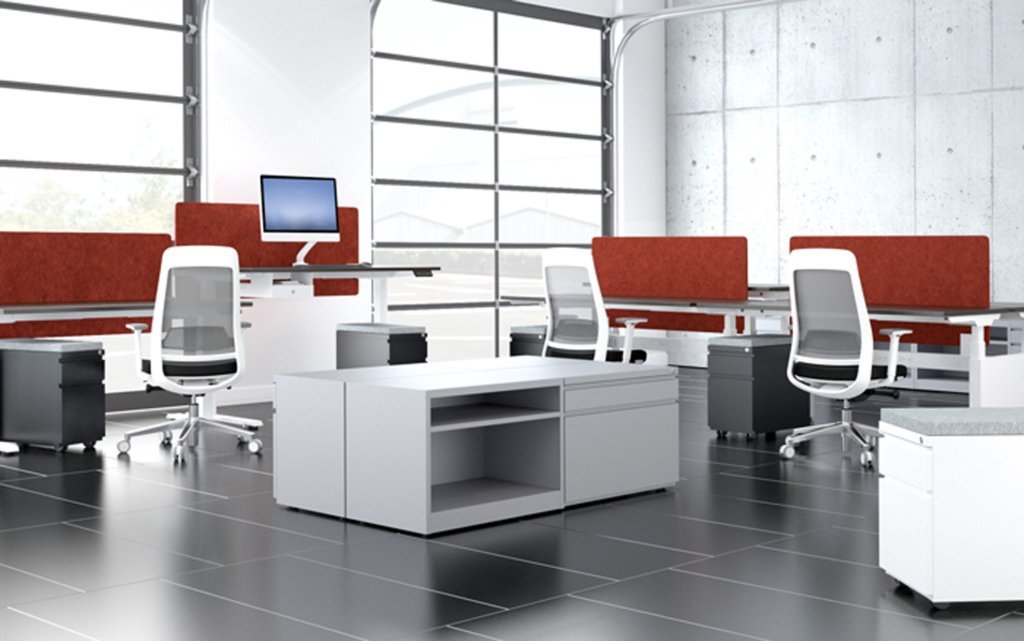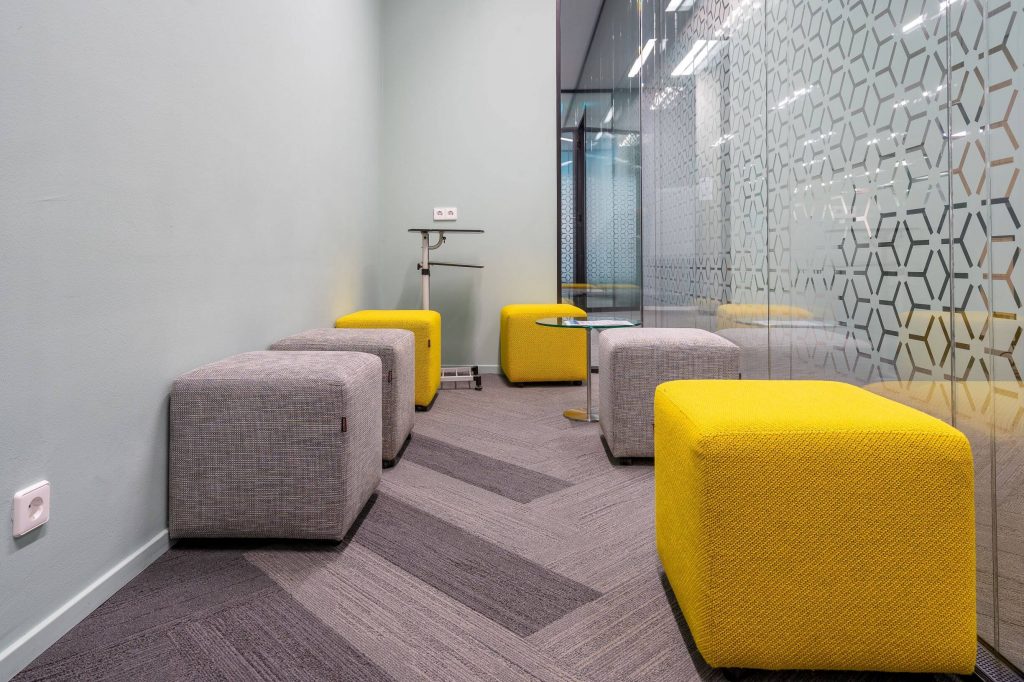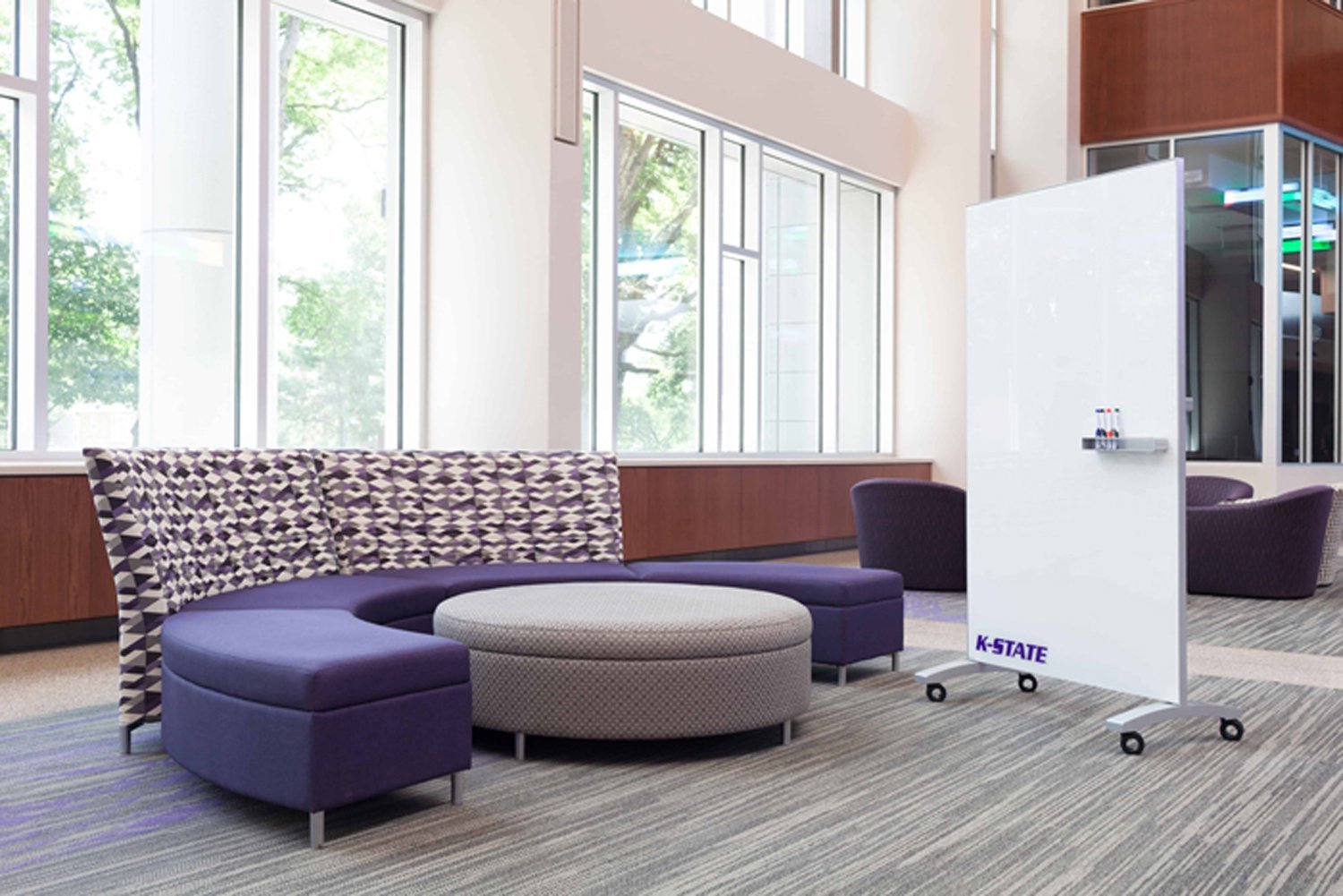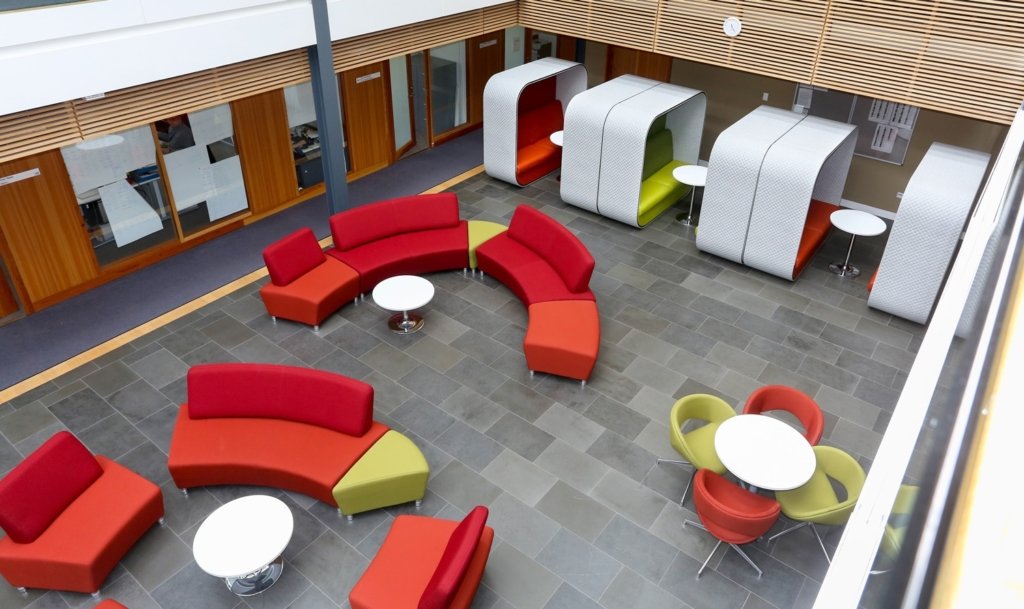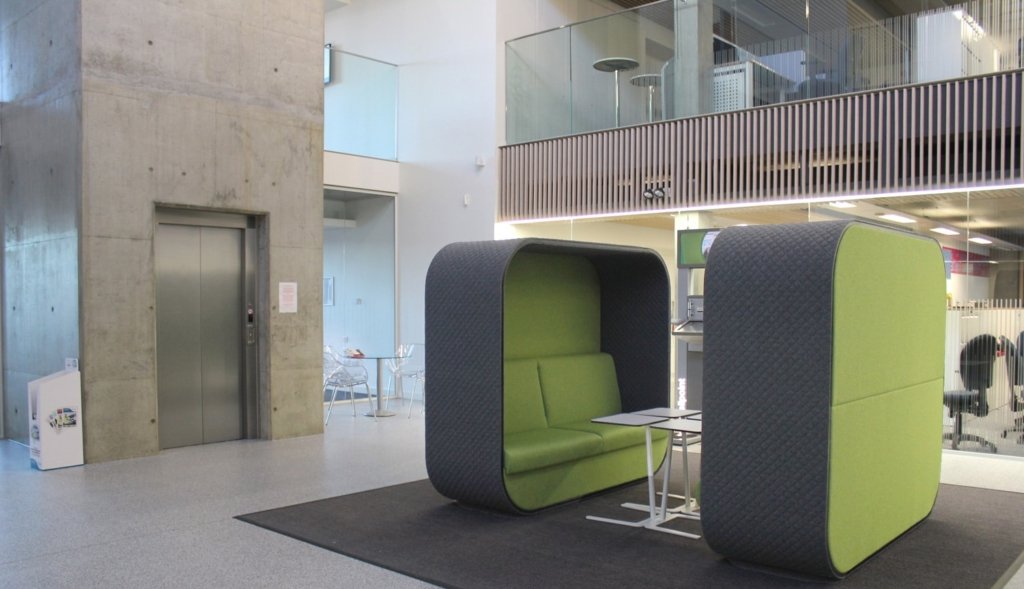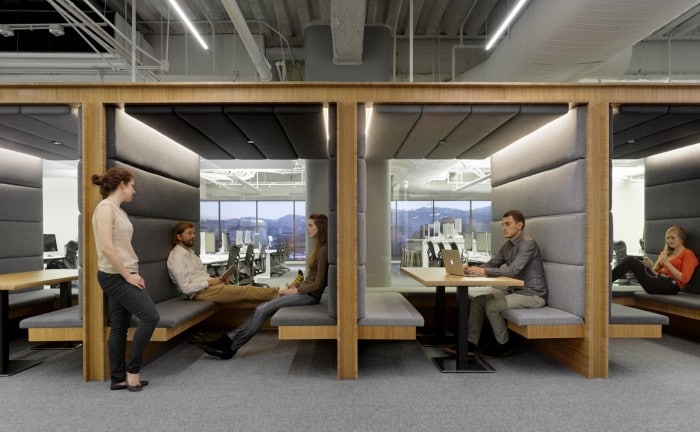Top 10 Healthy Workspace Designs in 2025

As a business owner, keeping your employees healthy and happy is a primary concern.
When employees are healthy, they are more engaged, productive, and tend to stay in their positions longer.
Office design for healthy employees can be more important than you think.
You might be wondering: What does office design have to do with healthy employees?
In short – everything. Of course, we can’t speak to every employee’s lifestyle choices outside of work, but in the office, there are many things you can do to design their workspaces to support optimum health.
In this article, you will learn about the top 10 healthy workplace design trends for 2025 to find a quick and practical way to improve your team’s health and productivity.
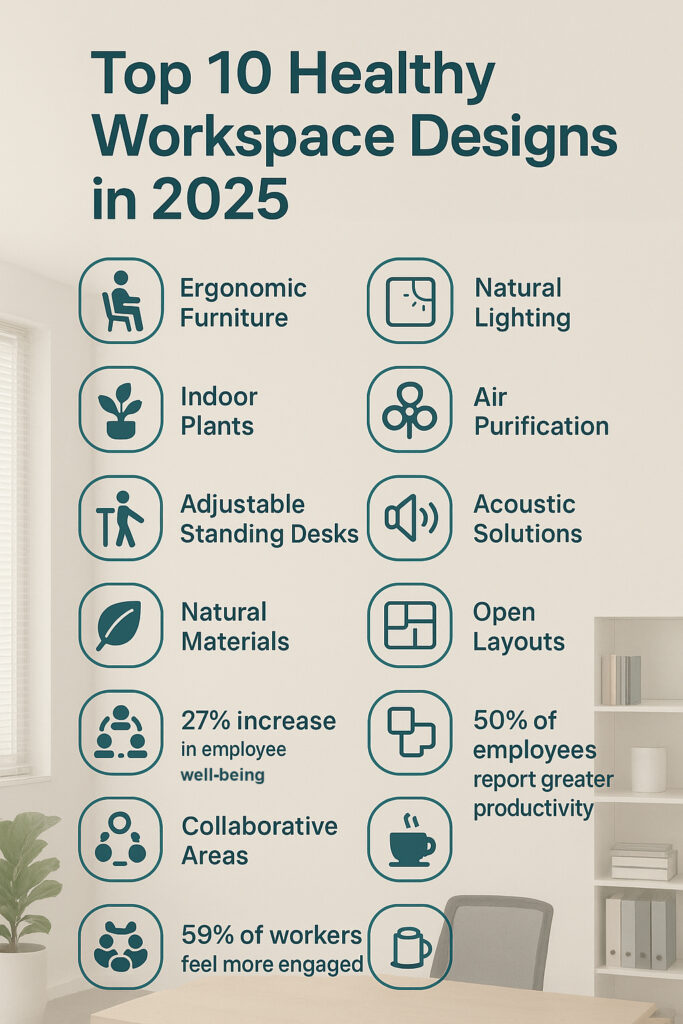
Why Healthy Workspace Design Matters in 2025
- Impact on physical health: Ergonomic design, maintaining correct body posture, and reducing fatigue caused by prolonged sitting.
- Impact on mental health: Reduces stress, increases concentration, and improves mood.
- Economic value for business: increased productivity, talent attraction and retention, improved employee satisfaction.
- Compliance with standards: Using certifications and standards such as the WELL Building Standard to ensure employee well-being.
- Effects of the environment on team interaction: Recent studies show that appropriate environmental design can improve team mood and cooperation and enhance the work results of groups.
You Might Also Enjoy: What No One Tells You About Buying Office Furniture in Houston
Top 10 Healthy Workspace Designs in 2025
1. Lots of Windows, Natural Light
Natural light is one of the most important elements in healthy workspace design, which has a direct impact on the physical and mental health of employees.
Access to natural light helps regulate the body’s circadian rhythm, improves sleep and daytime energy, and boosts mood and focus.
Additionally, natural light can reduce eye strain and headaches caused by artificial light, thereby increasing employee productivity.
In healthy workspace design, it is important to use large windows, transparent ceilings, skylights, and even reflective design to make the interior bright and pleasant.
Being able to see “outside the box” not only encourages out-of-the-box thinking, but it also gives the eyes and the brain a rest from staring at a computer screen all day long.
It also allows natural light to fill the office, which is much less taxing on our energy and focus.
2. Bring the Outside in with Biophilic Design
Biophilic design and the use of natural elements in the office space are two of the most effective ways to create a healthy workplace.
This type of design involves the use of natural light, indoor plants, and organic materials in the office space, which not only helps to beautify the environment but also has many psychological and physical benefits.
A little nature inside the office does wonders.
Plants produce oxygen and improve air quality.
They can also counter toxic chemical and gas emissions from Houston office furniture, carpeting, or poor air quality in general, making for a healthier environment.
Water features also provide a sense of well-being, whether it’s a waterfall in the reception area or a small fountain in the break room.
Natural features such as these have been proven to improve productivity and well-being in the office.
Research has also shown that the presence of natural elements in the workplace can reduce employees’ stress levels, improve mood, and increase creativity and focus.
Biophilic design makes the office experience more enjoyable and significantly improves team productivity.

3. Ergonomic and Movement-Friendly Workstations
Ergonomic and movement-friendly workstations are a main principle of healthy workplace design that significantly improves employees’ physical health and productivity.
Motion-based design not only increases energy and focus but also complies with WELL standards for a healthy workplace, demonstrating the importance of physical health in the modern workplace.
Such stations allow employees to get enough physical activity and make the office experience healthier.
While office chairs and desks are still a necessity, today’s designs are a far cry from what they used to be.
Ergonomic seating reduces fatigue, improves concentration, and lessens the incidence of pain related to sitting for long periods.
Modern desks and benching systems offer similar benefits by nature of their design; every aspect and feature of the desk is positioned thoughtfully and logically so that employees can comfortably reach everything they need to do their job.
Sitting at a computer workstation all day is not only monotonous, but it can have many negative impacts on employee health.
Prolonged inactivity may cause lower back pain, weight gain, and headaches, and it may also cause productivity to slow down or stall out over the course of a day.
Sit-stand office desks Houston are fully adjustable so that your teams can vary their position periodically, improving circulation, heart health, and psychological health as well.
You Might Also Enjoy: How to Optimize Office Space in 2025: 8 Ways
4. Wellness Rooms

Many companies today are choosing to provide wellness rooms for their employees.
Wellness and recharge zones are spaces in the workplace that allow employees to restore their minds and bodies and restore their energy.
These areas include meditation rooms, nap pods, and relaxation corners that allow you to get away from work pressure and focus on mental health.
This is a separate space where employees can go to focus on their health, release stress, get some quiet time, or simply have a place to go when they are not feeling well.
Some offices equip their wellness rooms with light therapy, massage chairs, or yoga mats for getting a mid-afternoon stretch.
As part of healthy workplace design, these areas demonstrate the importance of paying attention to employees’ mental health and providing a motivating and pleasant space for daily activity.
5. Acoustic Comfort and Noise Control
Acoustic comfort and noise control are important principles in healthy workspace design, especially in open office spaces where noise can severely reduce employee concentration and productivity.
To achieve this goal, it is important to use acoustic panels, quiet zones, demountable walls, acoustic pods, phone booths, and sound-adapting materials.
These solutions help reduce sound reflections, distracting noise, and audio distortion, allowing for deep concentration on important tasks.
Noise control increases the quality of work, improves the mental health of employees, and makes the work environment more pleasant and motivating.
As a result, acoustic comfort is an essential element in modern, open office design, which, along with other healthy workplace principles such as natural lighting and ergonomic furniture, can improve the overall employee experience.
 6. Resimercial Aesthetics
6. Resimercial Aesthetics
Another way to experience a healthy workspace design is to create a resimercial aesthetic, or a home-like feeling in the workplace.
This type of design is about creating a space that combines the comfort and intimacy of home with the office.
This design involves the use of soft lighting and comfortable, warm furniture, which makes the environment more intimate and pleasant.
Such an environment makes employees feel more comfortable and able to perform their duties with more motivation and peace of mind.
Research has shown that offices with a home-like design, in addition to increasing employee satisfaction, also improve team productivity, because people feel that their work environment cares about their well-being.
You Might Also Enjoy: Top 8 Office Furniture Rental Companies In Houston
7. Advanced Air Quality Monitoring Systems
Advanced air quality monitoring systems play a very important role in designing a healthy workplace, as clean and healthy air directly affects the physical health and concentration of employees.
These systems can measure and alert on levels of carbon dioxide, dust, pollutants, and humidity in real time, so that the working environment always remains optimal and healthy.
Using this technology, ventilation can be intelligently adjusted, preventing the accumulation of pollutants and reducing the risk of respiratory problems or fatigue caused by poor air quality.
Such a system is especially important in open offices and high-traffic spaces, and along with natural light, ergonomic furniture, and noise control, it is considered one of the most useful solutions for creating a healthy work environment and improving employee productivity.
8. Sustainable and Healthy Materials
Using sustainable and healthy materials is another way to create a healthy workspace design.
This approach includes the use of non-toxic finishes, renewable resources, and energy-efficient systems to ensure a safe and healthy work environment for both employees and the environment.
Using such material both prevents respiratory problems and allergies and strengthens a sense of responsibility and commitment to sustainability among employees.
In fact, an environmentally optimal office directly has a positive impact on the physical and mental health of employees and makes the office experience more enjoyable and motivating.
9. Implementing Healthy Practices in the Workplace
Creating healthy workplaces is not just about the beauty of the office or the well-being of employees; it is strongly supported by data and tangible results.
Studies show that employee illness and wellness management programs can reduce healthcare costs and generate significant returns on investment.
But how can these principles be turned into practical actions?
Implementing healthy practices includes several main areas:
- Prioritizing the physical and mental health of employees: including periodic check-ups, exercise programs, counseling, and stress management workshops.
- Optimize nutrition: Provide healthy snacks in the cafeteria and workplace.
- Encourage mobility and movement: Use short breaks, walking sessions, and height-adjustable desks.
- Smart use of technology: Simplify processes and collect valuable data to improve employee performance and well-being.
- Support remote workers: Guide to creating an ergonomic, organized, and clutter-free work environment at home.
By integrating these strategies, not only is a healthy and motivating work environment created, but the productivity, job satisfaction, and overall well-being of employees are tangibly increased.
Ultimately, a healthy workforce is a happy workforce, which directly contributes to business success.
You Might Also Enjoy: Top 10 Benefits of Using Recycled Office Furniture in Houston
 10. Thermal Comfort in the Workplace
10. Thermal Comfort in the Workplace
The ideal office temperature and thermal conditions are not the same for everyone, and paying attention to employee thermal comfort can have a significant impact on productivity.
Studies show that when people have the ability to adjust the temperature of their environment to suit their needs, they feel more comfortable and their work performance improves.
Using smart HVAC systems that allow for personalized temperature control can also reduce energy consumption by around 16%.
Creating a space where employees can regulate their own temperature is an essential part of designing a healthy, modern workplace and makes the office experience more pleasant.
Conclusion
As we know, designing healthy workplaces is vitally important in 2025 because it directly impacts employees’ physical and mental health, productivity, job satisfaction, and team engagement.
By implementing the principles mentioned in this article, you can create a better work experience for employees and create a dynamic and motivating environment.
If you’re looking for a practical guide to improving your workspace, the article “Top 10 Healthy Workspace Designs in 2025” can be a good starting point.
Today, you can examine your office, identify its strengths and weaknesses, and make the necessary changes to create a healthy and inspiring work environment.
If you are looking for office design ideas to support healthy employees, we’ve got plenty of them!
Reach out today to schedule a consultation or to learn more about what we can do for you with our office space planning service.

John Ofield is the owner of Collaborative Office Interiors. Houston’s trusted source for modern and commercial office furniture, office cubicles, demountable walls, office desks and tables, and complete workspace solutions. With more than 40 years of experience, he combines deep product knowledge with hands-on space-planning expertise to create ergonomic, productivity-focused work environments for businesses across Southeast Texas.


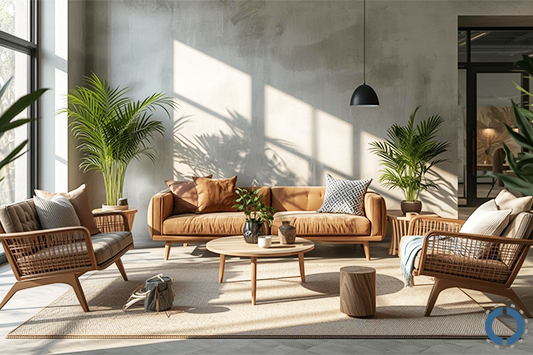 6. Resimercial Aesthetics
6. Resimercial Aesthetics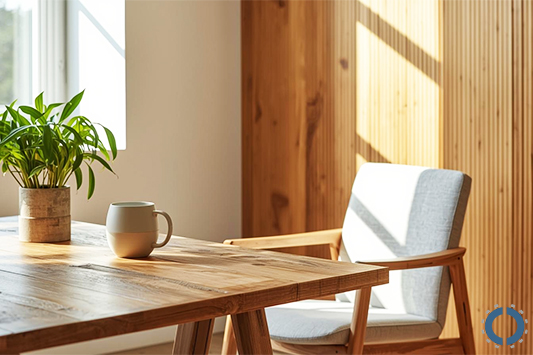
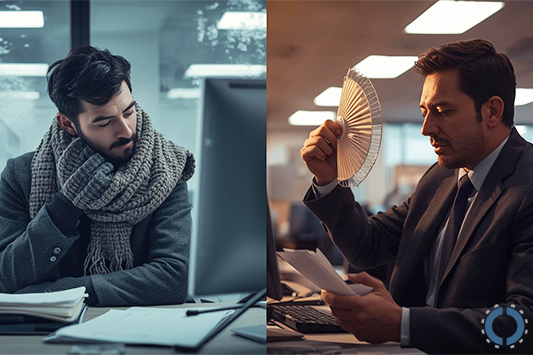 10. Thermal Comfort in the Workplace
10. Thermal Comfort in the Workplace